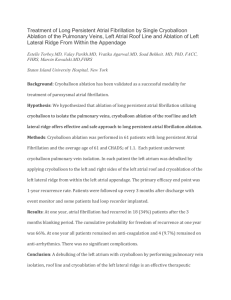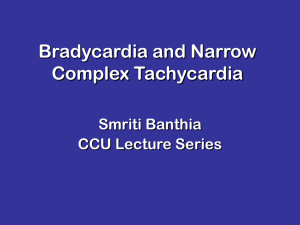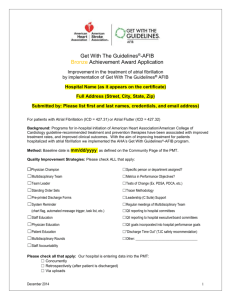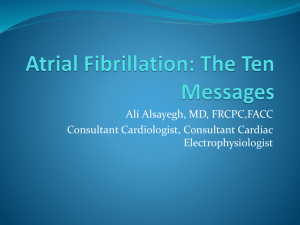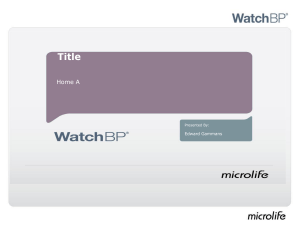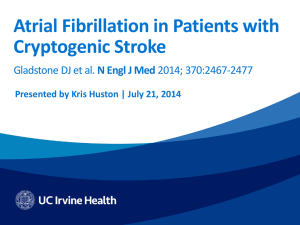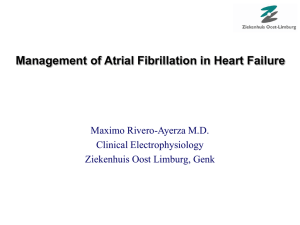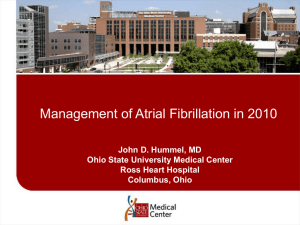Prevention of Atrial Fibrillation
advertisement
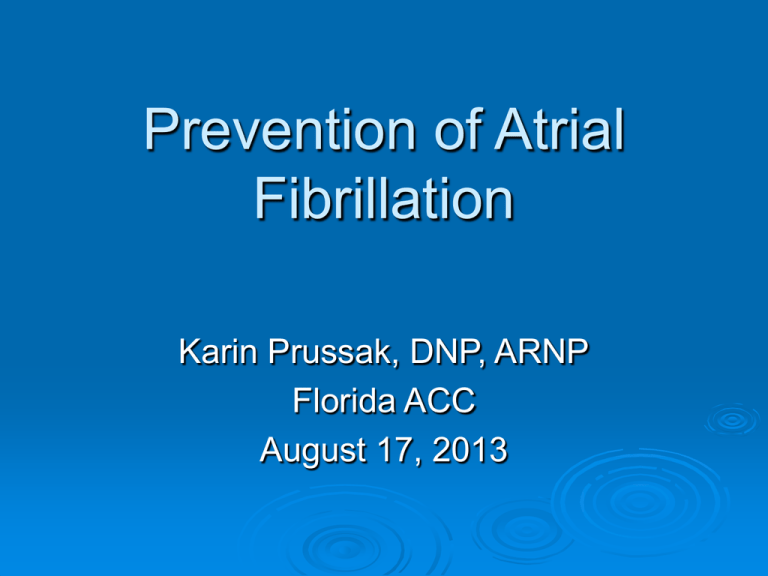
Prevention of Atrial Fibrillation Karin Prussak, DNP, ARNP Florida ACC August 17, 2013 Objectives 1. 2. 3. 4. Evaluate the economic burden of AF List the most common risk factors of AF. Identify risk factor modification to decrease risk of AF based on current research studies. Apply EBP to decrease risk of AF Healthy People 2020 For 3 decades, Healthy People has established benchmarks and monitored progress over time in order to: Encourage collaborations across sectors. Guide individuals toward making informed health decisions. Measure the impact of prevention activities. http://www.healthypeople.gov/2020/about/default.aspx What Are Some of the Main Objectives of Health Care Reform Legislation? H.R. 3962 authors project that 96% of the U.S. population will have health coverage under the legislation, which includes an optional public insurance program H.R. 3590 authors project that 94% of the U.S. population will have health coverage and does not include a public insurance option Reform the health care insurance system by eliminating pre-existing conditions, mandating coverage of certain conditions, capping out-of-pocket expenditures, creating health insurance exchanges, etc. Revising various Medicare Programs Expanding Medicaid Programs Ensure an adequate workforce to meet current and future population needs Expand health care services in medically underserved areas, including schools Cost reductions/Health care delivery advancements information technology (IT) advancements improving the quality of care using evidenced-based protocols pricing transparency supporting prevention and chronic care management boosting public health infrastructure emphasizing personal responsibility http://www.cherokee.org/docs/Services/Health/Health_Care_Reform_QA_revised.pdf Epidemiology of AF AF has become an epidemic in the United States and world wide: “An outbreak or product of sudden rapid spread, growth or development.” Over 5 million people have AF at this time and this is expected to increase to over 12 million in the next 20 years. Lip, Kakar & Watson, 2007; Go, et al., 2001; Chen & Shen, 2007. Incidence Per Age Group Epidemiology Lifetime risk of developing AF in individuals over 40 is one in 4. AF is seen in 1% of the population and the prevalence in adults under 55 is 0.1% and 9% in octogenarians. Prevalence increases with the severity of heart failure or valvular heart disease. Occurs more often in men than women. Accounts for 34.5% of all patients hospitalized for arrhythmia. Transient AF can occur in 15-40% of CV surgery patients. Fuster, V., et al. (2001). ACC/AHA/ESC guidelines for the management of patients with atrial fibrillation. Circulation, 104, 2120. Economic Burden of AF $6.65 billion in total treatment costs: Hospital: $4.88 billion Outpatient: $1.53 billion Medications: $235 million Coyne, et al. (2006). Cost Not only is AF an economic burden to the citizens of the US, but the secondary effects of AF are also costly: Stroke Disability Tachycardia induced heart failure Heart failure Decreased quality of life Significance of Problem Overall risk of developing AF is rising. Increasing prevalence and incidence of AF Disabling co-morbid conditions such as heart failure, CHF, stroke, depression, anxiety and other arrhythmias. Medical and interventional treatments are available but are not without risk, adverse effects and do not cure AF or decrease mortality or morbidity. 80% of subjects which present with AF have at least one risk factor. Lloyd-Jones et al. 2004; Ruigomez, Johannson, Wallander & Rodriguez 2002. So…. Despite the aging population, history of CHF, MI and hypertension, these factors alone are not sufficient to explain the growing incidence of AF. Known Risk Factors of AF Hypertension Advancing Age Valvular Disease (RHD) Hyperthyroidism Cardiomyopathy Heart Failure Coronary Artery Disease Diabetes Mellitus Sepsis Obesity Obstructive Sleep Apnea Metabolic Syndrome Genetic predisposition Cardiothoracic surgery: CABG and valvular surgery Previous episodes of AF Esophageal resection Wu et al., 2005; Chen & Shen, 2007; Gami et al., 2007; Lip et al., 2007; Watanabe et al., 2008; Fuster et al., 2006; Otway, Vandenburg & Fatkin, 2007. Can we prevent AF? Primary prevention of AF Focus on modifiable risk factors: Obesity OSA Hypertension Hyperthyroidism Heart failure Metabolic Syndrome Cardiothoracic surgery Develop prevention/risk reduction strategies to reduce risk of primary and secondary AF. Pathophysiology of AF Atrial fibrosis and loss of muscle mass Expression of angiotensionconverting enzyme increased 3-fold during persistent AF Increase in left ventricular hypertrophy led to increase in left atrial dimension which increases the risk of AF http://www.hrsonline.org/Policy/ClinicalGuidelines/upload/AFGuidelinesFullText.pdf Atrial stretch can cause AF and AF can cause atrial dilation Inflammation Autonomic Nervous System activity Atrial ischemia LV diastolic dysfunction affects stretch receptors in the pulmonary veins or directly affects atrial myocardium. AF Risk Factor Causal Model Obesity Overweight Increased Left Atrial Diameter (LAD) Left Ventricular Enlargement or Hypertrophy Hypertension Heart Failure Prussak, K. (2008). Prevention of New-Onset Atrial Fibrillation. New Onset Atrial Fibrillation Genetics Increased relative risk of 1.85% in offspring of one or both parents with AF Cannot change genetics Offspring should be evaluated for increased risk of AF Fuster, et al. 2006. Increasing Age Increased prevalence with increasing age. Risk higher in men, but women are now living longer, which places a larger population at risk for AF. Cannot change risk of age, only risk reduction of other risk factors. Obesity The CDC defines adults as overweight if the Body Mass Index (BMI) is 25-29.9 and obese as BMI > 30. In 2006, prevalence of obesity in males was 33.3% and 35.3% in women. 72 million Americans are obese and adults aged 40-59 have the highest prevalence of all age groups. Prevalence of obesity in Florida is reported to be 23.6% http://www.bodyshapingtips.com/images/BMI-Chart.png Obesity and AF Risk of AF increased 5% for each one unit increase in BMI. Significant difference noted in LAD in obese men compared to overweight men (p<.001). Increased risk of AF with increased LAD and LVH. Wang, T. et al.JAMA, 2004; Pritchett, A. et al.J Am Coll Cardiol, 2003; Frost, Hune & Vestergaard, Am J Med, 2005; Ruigomez,,A. et al.,J Am Epidem, 2002; Gami, A. et al., J Am Coll Cardiol, 2004. Obstructive Sleep Apnea (OSA) OSA affects 17-24% of adults and is present in 40-90% of overweight and obese subjects. A retrospective cohort study by Gami et al. (2007) followed 3542 subjects for 4.7 years and revealed that BMI and OSA are both strong predictors of AF together and independently. Kanagala, R., et al. (2003). Circulation; Gami, A., et al. (2007). J Am Coll Cardiol Hypertension Double-blind randomized study of 8831 pts with HTN. Received losartan and atenolol. Assessed LV size 12.4% lower risk of AF with decrease in LV size (Cornwell product) Okin, P., et al.(2006). JAMA. Heart Failure The prevalence of AF in patients with HF ranges from 10 to 30% This has been observed to increase in proportion to the severity of HF from <10% in those with New York Heart Association (NYHA) functional class I HF to approximately 50% in those with NYHA functional class IV. Maisel, W. et al. (2003). Am J Cardiol; Stevenson, S., et al. (1999). N Engl J Med . SOLVD Trial Retrospective analysis revealed after 2.9 years of follow-up, 5.4% of patients receiving enalapril vs. 24% in placebo group developed AF. Vermes, E., et al. (2003). Circ. Hyperthyroidism Increases risk of developing AF Thyroid hormone influences arrhymogenic activity of atrial myocytes. AF occurs in 10-15% of patients with hyperthyroidism. Treat with thyroxine and beta blockers Treatment results in conversion to sinus rhythm is 2/3 of patients. Jayaprasad, N. & Johnson, F. (2005). Indian Pacing Electrophysiol J. Metabolic Syndrome National Cholesterol Education Program defined MS if at least 3 of the following factors are met: Elevated BMI Elevated triglycerides Low HDL Increased BP Impaired glucose tolerance NCEP-ATP III Metabolic Syndrome and AF 28,449 Japanese subjects followed for a mean of 4.5 years in a prospective study. AF developed in 265 participants All components except for high triglycerides contributed to the development of AF 3 or more components of MS revealed a HR of 3.27 and obesity and elevated BP contributed substantially to increased risk of AF. Watanabe, H., et al. (2008). Circ. Predictors of Post-op AF Advanced age Male gender Digoxin Peripheral arterial disease Chronic lung disease Valvular heart disease Left atrial enlargement Previous cardiac surgery Discontinuation of beta-blocker medication Preoperative atrial tachy-arrhythmias Pericarditis Elevated postoperative adrenergic tone Creswell, et al. (1993) Prevention of Peri-operative AF BMI >30.1 predicts increased risk of AF Post-operative amiodarone decreased risk of AF from 47% to 35% Beta blockers protected against AF Statin therapy pre-op not associated with decreased incidence of AF Sotalol was found to be more effective in reducing AF than beta blockers or placebo. PUFA’s lower risk of AF post CABG AF is self-limiting IV Magnesium Sulfate Fuster, et. al. (2006); Calo, et al. (2005); Saravannan et al. (2009). Polyunsaturated Fatty Acids and AF (PUFA) Reference Study Design Subjects Conclusion Physician Health Study Prospective 17679 pts AF risk higher in PUFA group Danish Study Prospective 47949 pts Stat. insignificant Rotterdam Study Prospective 5184 pts Stat. insignificant Mozaffarian et al Prospective 4815 pts 28% lower AF risk in broiled/baked fish group Calo et al. Prospective 160 CABG AF risk lower in PUFA group Saravanan et al Prospective CABG pts AF risk lower in PUFA group Aizer, A. et al., Heart Rhythm, 2006; Brouwer, I., et al., Am Heart J, 2006; Calo, L., et al., J Am Coll Cardiol, 2005; Frost, L., et al., Am J.Clin Nutr, 2005; Mozaffarian, D. et al. Circ, 2004; Saravanan, P., et al., Heart Rhythm, 2009. Vitamin C Anti-oxidant and Anti-inflammatory Reference Subjects Conclusion Carnes et al. Vit C before and 5 days after CABG 43 pts 16.3% vs. 39% developed AF Korantzopoulos et al. 2g Vit C 12 hr prior to CV and 500 mg BID for one week after CV 44 pts 4.5% vs. 36.3% developed AF after 1 week Carnes, C. et al. (2001). Circ; Korantzopoulos, P. et al.(2005). Int J Card . Statin Therapy Pellegrini, et al. (HERS study) studied 2763 postmenopausal women with heart disease randomized to HRT or placebo. Data revealed 55% decrease in AF incidence compared to women not taking statins 65% decrease in prevalence of AF in statin therapy subjects. Pellegrini, C., et al. Heart Rhythm Society (HRS) Annual Scientific Sessions; May 14-17, 2008, Statins: Meta-analysis 6 studies with total 3,557 subjects in sinus rhythm. 3-studies with use of statins in PAF or persistent AF prior to CV; 3 studies with primary prevention of AF in patients undergoing CABG or post MI. Use of statins was significantly associated with decreased risk of AF compared to controls (odds ratio 0.39). Benefit of statin therapy increased in secondary prevention of AF than new-onset or post-op AF (OR 0.60). * Use of statins was significantly associated with decreased risk of incidence or recurrence of AF in pts in sinus rhythm with history of AF, undergoing cardiac surgery or AMI. Fauchier, L., et al. (2008). J Am Coll Cardiol. “Upstream Therapies” “Refers to the use of non-anti-arrhythmic drugs which modify the atrial substrate, or target-specific mechanisms of AF to prevent the occurrence or recurrence of arrhythmia”. ACEI Beta Blockers ARB PUFA Vitamin C Statins Although some retrospective and small study results in selected categories have been positive, larger prospective studies have generated controversial and mostly negative results. Results remain inconclusive. Savelieva, I., et al. (2011). Europace. Previous Episode of AF and Secondary Prevention “Atrial fibrillation begets atrial fibrillation” Wann, L.S., et al. (2011). 2011 ACCF/AHA/HRS Focused Update on the Management of Patients With Atrial Fibrillation (Updating the 2006 Guideline). Recommendations? Maintain lower BMI Control BP Treat OSA Treat abnormal thyroid function ACEI, ARB and BB for hypertension and heart failure (jury is still out…) Consider PUFA, Vitamin C Preoperative prophylaxis Case Study #1 Mr. P is a 75 year old male with a BMI of 29, hypertension, normal TSH, no family history of AF and snores with apneic episodes. Echo reveals LVH, left atrial dimension of 49 mm, EF of 51% and mild MVR. How can his health care provider lower his risk of AF? Case Study #2 Mrs. R is a 52 year old female with chronic diastolic heart failure, TSH of 0.01, mother with persistent AF and being prepared to undergo CV surgery for MV replacement. How can you decrease this patient’s risk for AF? Evaluation /Suggestions Lack of studies which focus on prevention of new-onset AF strategies with modifiable risk factors New directed approaches for prevention of AF are necessary to halt this every-increasing public health crisis. Implementing AF risk reduction strategies aimed at modifiable risk factors such as obesity, OSA, hypertension, heart failure and pre-operative interventions may impact the escalating incidence of AF in the population and will ultimately decrease the healthcare burden of associated co-morbidities of AF.
